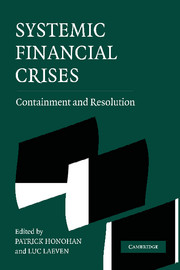Book contents
- Frontmatter
- Contents
- Contributors
- Foreword
- Acknowledgments
- PART ONE INTRODUCTION
- PART TWO CONTAINMENT AND RESOLUTION
- PART THREE MODELS AND ECONOMETRIC EVIDENCE
- PART FOUR STRUCTURAL REFORMS
- 7 Financial Crises and the Presence of Foreign Banks
- 8 Maximizing the Value of Distressed Assets: Bankruptcy Law and the Efficient Reorganization of Firms
- 9 Crisis Resolution and Credit Allocation: The Case of Japan
- Appendix: Banking Crisis Database
- References
- Index
8 - Maximizing the Value of Distressed Assets: Bankruptcy Law and the Efficient Reorganization of Firms
Published online by Cambridge University Press: 24 August 2009
- Frontmatter
- Contents
- Contributors
- Foreword
- Acknowledgments
- PART ONE INTRODUCTION
- PART TWO CONTAINMENT AND RESOLUTION
- PART THREE MODELS AND ECONOMETRIC EVIDENCE
- PART FOUR STRUCTURAL REFORMS
- 7 Financial Crises and the Presence of Foreign Banks
- 8 Maximizing the Value of Distressed Assets: Bankruptcy Law and the Efficient Reorganization of Firms
- 9 Crisis Resolution and Credit Allocation: The Case of Japan
- Appendix: Banking Crisis Database
- References
- Index
Summary
INTRODUCTION
Earlier chapters have stressed the importance during the resolution of a systemic financial crisis of preserving asset value and helping ensure a quick recovery of economic activity. Key to achieving these goals is the presence of an effective bankruptcy system. But which type of system is likely to be most effective? Many observers have noted the historical differences between U.S. corporate bankruptcy procedures and those in other countries. The U.S. law has been described as “debtor-friendly,” oriented toward reorganizing the existing company (i.e., giving the debtor a second chance), and accustomed to deviating from contractual payoff priorities. The traditional bankruptcy procedures in many other developed countries including the United Kingdom, Germany, Japan, and Sweden are described, in contrast, as “creditor-friendly,” favoring the liquidation of the debtor's assets to pay off creditors in the order of their priority. A relatively large literature has arisen debating the relative merits of each system.
Perhaps with an eye to the perceived success of the U.S. system, many countries have recently begun to institute more debtor-friendly, U.S.-styled reorganization codes into their bankruptcy laws. Indeed, the World Bank, International Monetary Fund (IMF), and the European Union (EU) now encourage member countries to adopt bankruptcy laws that have a reorganization code as one of their cornerstones. Thus, from a public policy standpoint, U.S.-styled bankruptcy procedures appear to be quickly gaining the upper ground as the preferred mechanism for dealing with distressed companies.
- Type
- Chapter
- Information
- Systemic Financial CrisesContainment and Resolution, pp. 232 - 275Publisher: Cambridge University PressPrint publication year: 2005
- 12
- Cited by



